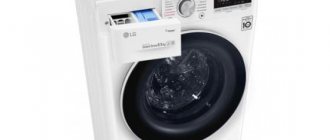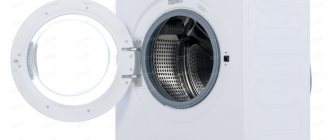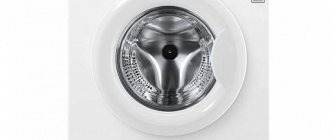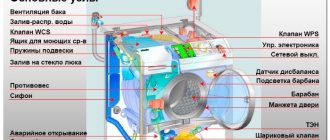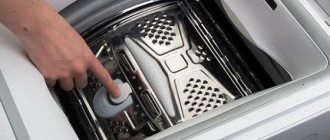In the old days, people washed clothes by hand. Among the devices they had: a wooden tool (roller), a pelvis or vat, a solution of sifted ash (lye) or a decoction of soap root. The lye washed clothes very well; they did their own laundry at home or hired laundresses. With the advent of the first machines, laundresses, alas, were left without work.
The linen was boiled in a lye solution in a stove, on a stove, or specially heated, hot stones were placed inside the vat, causing the water to boil. Next, a lump of laundry taken from the vat was placed on a bench and beaten on it for a long time with a wooden tool - a roller - until the soap solution stopped splashing.
How they washed clothes before the fifties
You may be interested in: Is regretting useful or harmful?
They washed it in the bathroom, in basins, in troughs. To help housewives there was a brilliant invention in 1797 - the washboard. The soapy laundry was rubbed across the ridges of the device, and all the dirt fell off. The name "washboard" survives as a metaphor for poor quality roads.
RAF-2203 "Latvia"
Soviet minibus, produced by Riga Auto from 1976 to 1997. He successfully replaced his predecessor RAF-977. RAF-2203 became the most popular and almost the only minibus model in the USSR. It was produced at a rate of 18 thousand copies per year with a total final result of 274,000 cars of all modifications.
According to the designers’ original plan, the minibus should have been completely unified with the units of existing Soviet cars. The main elements are taken from the Volga GAZ-24, wheel caps from the GAZ-21, the dashboard from the GAZ-24, chrome mirrors and taillights from the Moskvich-412 car.
The power unit was an engine from the Volga GAZ-24, which was located in the cabin between the front seats. The front suspension is independent, spring, on wishbones. Shock absorbers are hydraulic, telescopic, with reinforced springs. The rear suspension is dependent, on semi-elliptical longitudinal springs. The salon was divided into two compartments: for the driver and front passenger, who sat on the front wheel covers, and a passenger compartment for 10 seats with a passage to the rear row of seats.
The main modifications of the RAF-2203 include: RAF-2203 a basic passenger minibus with 10 seats, an ambulance - RAF-22031 with several subsequent upgrades, a minibus - RAF-22032 with a derated ZMZ-2401 engine, as well as specialized minibuses of the RAF traffic police -22033 and fire command vehicles RAF-22034. In total, more than 90 different modifications were produced based on the RAF-2203.
The first washing machines
According to some reports, the first washing machine was patented by Noah Kushin, who invented the first manually operated device, where you had to turn a special handle.
You may be interested in: Vedic culture of the ancient Slavs: history, language, facts and legends
The very first cars were made in 1851 in America by James King. They were powered by a handle. In 1874, William Blackstone invented the first household washing machine. A unit with an electric motor was born in 1908, it was invented by Alva Fischer.
ZAZ-968M “Zaporozhets”
In 1979, another modernization appeared - the ZAZ-968M, which had rectangular rear lights instead of round ones, a new convex front panel with a middle black stripe and the inscription “968M”, as well as rectangular direction indicators. In addition, this modification, along with the base one, was equipped with a 50-horsepower MeMZ-968BE engine.
The engine cooling system was structurally changed, where air began to flow through a stamped grille in the hood: the “ears” were replaced with small “gills”, where the right grille was used for air intake, and the left one for exhaust.
The first washing machines in the USSR
How and when did they appear? For the first time in the USSR, washing machines began to be installed in the apartments of government officials in 1925. These units were imported from the USA. The first Soviet plant for the production of washing machines was the Riga RES plant. It must be said that the products of the Baltic factories at that time were in great demand and respect due to their quality.
Today, photos of the first washing machine in the USSR can be found in old magazines. So, in 1950, two models were manufactured - EAYA-2 and EAYA-3, which retailed at a price of six hundred rubles with a cost of one and a half thousand - the rest was paid to the factories by the state. It must be said that one and a half thousand rubles was an absolutely monstrous price for those times.
You may be interested in: What is a prism? Types of figure. Formulas for volume and area. Prism in physics
The EAYA-2 washing machine was quite progressive. It had an interesting design. The machine had a vertical loading, a steel drum tank, inside of which steel blades rotated. The machine did not have a timer; the owner had to determine the washing time by eye, usually about twenty to thirty minutes. It is curious that the machine had the function of a centrifuge: by switching the lever, the drum itself rotated, and the blades were motionless, which was how the liquid was squeezed out. The USSR washing machine had retractable wheels, and during operation it was installed on shock-absorbing rubber supports.
The washing machines of the next release, “Riga-54,” were very similar to the robot Erdvadva from the movie “Star Wars” and were designed for 2.5 kg of laundry. The next model, Riga-55, completely copied the Swedish car.
ZIL-4102
When the ZIL-4102 was created, it was supposed to be the successor to the famous ZIL limousine, which was used for many years by government servants and senior officials of the Communist Party of the USSR.
The ZIL-4102 was equipped with front-wheel drive and also had carbon fiber body elements: roof panel, trunk lid, hood and bumpers.
Two prototypes were built in 1988. It was originally planned that the model would be equipped with three types of engines: 4.5 liter V6, 6.0 liter V8 and 7.0 liter diesel.
Since this model was intended for the elite, naturally the car was equipped with elements of luxury and comfort. So the car had electric windows, ten audio speakers, a CD player, an on-board computer and a white leather interior.
Unfortunately, Mikhail Gorbachev was not impressed with the ZIL-4102, and he did not approve the project. That is why the luxurious ZIL never went into mass production. It's a pity. We believe that if this model had appeared in mass production, our auto industry would look different today.
How washing units have improved
In 1966, a timer appeared in the USSR washing machine: an extremely unreliable unit that could be used to regulate the washing or spinning time. Thus, it was already an automated washing machine. It was extremely difficult for citizens to buy a car: they had to stand in line for three to five years.
A few years later they released the first semi-automatic car, it was called “Volga-10” and it was made in Cheboksary. They are still preserved in pensioners' homes.
VAZ-E2122
AvtoVAZ had another experimental car project, which received the code designation VAZ-E2122. It was an amphibious vehicle project. Development began in the 70s of the last century.
The most amazing thing is that the vehicle moved through the water using ordinary wheels. As a result, the maximum speed of the car on water was only 5 km/h.
The car was equipped with a 1.6 liter gasoline engine, which transmitted torque to all four wheels.
Unfortunately, due to adaptation for movement on water, the car had many design problems. So the engine, transmission and front differential often overheated due to the fact that these components were located in special closed housings. This was necessary to protect vehicle components from water.
In addition, the car had terrible visibility. There were also significant deficiencies in the operation of the exhaust gas system.
Despite a number of difficulties and problems during the development of the vehicle, the USSR military department was interested in mass production of an amphibious SUV. As a result, the Ministry of Defense of the Soviet Union ordered several prototypes from AvtoVAZ. But unfortunately, this progressive car project never reached mass production.
The rise of primitive washing machines
After the simplest design of washing machines was tested and debugged, many enterprises began producing household appliances similar to each other. As a rule, they were made at defense enterprises as consumer goods. There was such a national economic plan for them: to produce goods for the population. As they say, in the morning there are rockets, in the evening there are washing machines and vacuum cleaners made of the same metal. The products of defense factories were of excellent quality.
What other brands of cars were produced in the USSR? “Oka”, “Ural”, “Siberia”, “Zarya”. All of them were structurally similar and usually consisted of an unaesthetic tank in the form of a top-loading barrel, at the bottom of the tank there were electric drive blades, and the motor itself was located at the bottom. Sometimes a squeezing device was attached to the top. There are photos of USSR washing machines in the article.
[edit] Export
See also for more details
:Export of washing machines from Russia
Since 2022, Russia’s exports of washing machines have exceeded imports, and the country has become a net exporter of washing machines.
Exports of household washing machines from Russia in 2022 increased by 26% to 1,779 thousand units. This is another absolute record. For the third year in a row, there has been a significant increase; during this period, deliveries have increased more than 4 times. Since 2022, Russia ranks 7th in the world in exports of washing machines (after China, Poland, Turkey, Thailand, Italy and Slovakia). In value terms, exports amounted to $319 million (+36%).
Washing machines like “Oka” are an example of a never-ending classic
What is the structure of the most classic car from the times of the USSR and, oddly enough, today? The Oka washing machine is an activator type. It does not have a rotating drum, but a stationary vertical tank, at the bottom of which blades are installed - they mix the washing solution with the laundry. This design was distinguished by its simplicity and enormous reliability. Machines of this type could easily operate for several warranty periods.
The structure of an old USSR washing machine: there is a metal (now plastic) barrel, inside of which an electric drive and a fixed tank are mounted. That's all, actually. There are switches to turn on and sometimes, in some models, a timer that controls shutdown. The machine is extremely reliable and, if used correctly, practically does not break down. Typical rare breakdowns include leakage of the cleaning solution through the seals, destruction of the blades and burnout of the engine. The last two defects occur due to overload. Also, the manufacturer strongly does not recommend doing several washing cycles in a row. After completing one cycle, you should take a break and let the machine rest.
You will be surprised, but the Oka washing machine in various modifications is still sold today and costs about three thousand rubles. What is especially good about Oka is that it does not require insertion into the water supply.
NAMI-0284 “DEBUT”
In 1987, the Russian Research Automobile and Automotive Institute (NAMI) developed a front-wheel drive prototype of the car, which was presented at the Geneva Motor Show in March 1988. The vehicle received the code designation NAMI-0284.
This car attracted enormous public attention at exhibitions and received many positive reviews from critics and experts of the global car market. The car had a unique feature for that time - an impressively low coefficient of aerodynamic drag (only 0.23 cd)
This is surprising since many modern cars cannot boast of such aerodynamic characteristics.
The car had a unique feature for that time - an impressively low coefficient of aerodynamic drag (only 0.23 cd). This is surprising since many modern cars cannot boast of such aerodynamic characteristics.
The length of NAMI-0284 was 3685 mm. The car was equipped with a 065 liter engine, which in those years was installed in the Oka (VAZ-1111).
In addition, the experimental model was equipped with electronic servo steering and cruise control.
Despite the low power engine (35 hp), given the light weight of the car (less than 545 kg), it was capable of accelerating to 150 km/h.
The era of drum devices - semi-automatic devices
Progress moved forward, and now they developed the first machine with front-loading laundry and a drum. This happened in the early seventies, the car was called “Eureka” and was semi-automatic. That is, the washing cycles were set by the programmer, but water had to be poured manually. The machine had a spin mode. Its disadvantage was that you had to pour the water yourself. Since it was not always possible to accurately measure the amount of liquid being poured, very often soapy water broke through the seals and flooded the bathroom floor, and therefore the neighbors. Electric motors of USSR washing machines often failed due to leaks.
Types of sewing machines
1) If we consider all the old sewing machines, then the most popular and in demand among antique collectors is the Singer, named after I. Singer. There are many interesting stories associated with this equipment, including the fact that some of its working elements are made of precious metal. However, this version has nothing to do with reality, although as an antique, the Singer sewing machine is indeed very valuable. Features of this model include:
- long shuttle;
- a double loop is created to capture when the needle and shuttle “meet”;
- massive flywheel;
- manual drive with two gears.
Many models of Singer machines, when handled correctly, still work perfectly to this day and are not inferior in quality to stitching to modern models of similar equipment.
2) “Podolsk PMZ” is a sewing machine widespread during the Soviet era, which won the sympathy of millions of craftswomen. Sewing equipment was produced in 1952 at the Kalinin plant. The machine is equipped with both foot and hand drive. The features of Podolsk PMZ include:
- central bobbin shuttle device;
- maximum rpm - 1.2 thousand;
- maximum stitch length - 4 millimeters;
- The machine is installed on a flat platform.
Many needlewomen successfully operate the Podolsk PMZ machine today.
3) A copy machine of the “Podolsk PMZ” model is “Minerva” - a machine made in Czechoslovakia.
A sewing machine from the German manufacturer Veritas was in demand in the seventies of the nineteenth century. Without a doubt, it can be called multifunctional, since, unlike the listed equipment models, it can sew buttonholes and make a zigzag stitch. A special feature of the sewing machine from the manufacturer Veritas is the shuttle rotating in a circle, which ensures high speed. In addition, this equipment can cope with sewing even very dense fabric, which can also be considered an advantage.
4) When analyzing old sewing machines, we should also mention the Tula model made in the USSR. It was released in the fifties of the last century. The uniqueness of the Tula machine lies in the fact that some of its components are borrowed from industrial sewing equipment. The machine is equipped with both manual and electric drive, and its pedal is incredibly convenient for the seamstress. Despite its versatility, this machine quickly lost its popularity. The reason for this was difficulties in maintenance.
5) A sewing machine of high quality is the Lada model, which was produced for the purpose of further export. The equipment performs both straight and zigzag stitching. The machine is also equipped with a flashlight, providing convenient working conditions.
6) Another antique electric sewing machine that deserves attention is the Bortelli model from a manufacturer in Italy. It was released in 1966. A notable feature of this machine is its design, which in many ways resembles a modern one.
Cars for students
At the same time, the development of compact, small-sized washing machines was carried out, bearing the once proper and now common name “Malyutka”. Most of all, it resembled a huge chamber pot: a relatively small plastic tank and an electric drive on the side.
The car was truly miniature and was perfect for students, bachelors, and families with children who did not have the money to purchase a more expensive and powerful model. These devices are still in demand.
Adolf Knoch sewing machine
The Knoch sewing machine was produced in Germany. German engineers are considered the founders of the design of sewing machines. Therefore, and for a number of other reasons, German sewing machines are considered reliable and of high quality. This model of Knoch sewing machine only performs one stitch. Despite the fact that it has a more modern look and a modern device for winding thread on a bobbin, it is quite simple and is not very suitable for sewing modern knitted fabrics. The price of such a machine in perfect condition, fully equipped and operational, ranges from 1500-2000 rubles.
Automatic washing machines of the USSR
Citizens of the Soviet Union first became acquainted with an automatic car in the late seventies. In Kirov, under a license from a well-known Italian company, a plant was built that produced the first automated washing machines in the USSR, “Vyatka-automatic”. It was an exact copy of the company's products.
The machine was distinguished by excellent quality and many functions - a real robot, in fact. The device had such unprecedented properties that people from all over the region specially came to the lucky owners to look at the wonder. This machine cost a huge amount of money: four monthly salaries, and in order to purchase it, they were required to provide a certificate from the housing office - the current management company - that the condition of the electrical wiring allowed it to be connected. The fact is that the unit was designed for heavy electrical loads (due mainly to drying), and the wiring in old buildings could not withstand it, heat up and catch fire.
So, this was the first automatic washing machine in the USSR, like almost all previous ones, made according to foreign analogues. After that, there were several more modifications, and then the USSR collapsed, and the era of imported cars came, which we can see today in every apartment or house.
Source
GAZ-M1
In 1935, this model replaced the first mass-produced passenger car of the USSR - GAZ-A. The GAZ-M1, by analogy with the GAZ-A, was based on the successor to the Ford A - Ford 40 (Model V8 40-730) with the chassis modified to suit the harsh real conditions of Russia. The abbreviation “M-1” stood for “Molotovets-First” in honor of the Chairman of the USSR Government - V. Molotov, and the design and development work was carried out by Design Bureau A.A. Lipgart. A total of 62,888 copies of this model were produced by 1942.
The main innovation in the M-1 design was the all-metal body, created using advanced Ford body technology. The power unit was a modernized Ford A engine, but produced using original Soviet equipment. In addition, the design was changed, as a result of which the M-1 looked more modern even compared to its overseas prototype.
Based on the M-1, the following were manufactured: a taxi version, GAZ-415 - a 500 kg pickup truck, GAZ-11-73 - a modernized sedan with a 6-cylinder GAZ-11 engine, GAZ-61-73 - the first in the world 4x4 sedan, BA-20 - light armored car and another 14-15 small-scale modifications.
Case products
The washer body can be used to make:
- a box for various small items or tools;
- porthole window;
- lockable dog house;
- flower beds for various plants.
Box for various small items or tools
Any semi-automatic machine with a horizontal load is suitable for making such a box.
To get a box from it, do the following:
- remove the top and back covers;
- remove the motor and tank with drum;
- measure the interior space;
- Make shelves according to these dimensions, taking into account the door protruding inward;
- in the upper part of the shelves, install a pair of 3-5 W lamps and connect them to the switch in the door lock, to reduce the load on the switch, use a relay;
- put the machine on its feet;
- insert the box inside it, secure it and replace the back and top covers;
- lay hidden wiring to the nearest outlet.
In the same way, you can make a minibar, then instead of light bulbs, install a New Year's LED garland with a controller. When the door opens, the garland will begin to flash, creating a unique play of colors.
Porthole window
To make such a window, you will need the door of a semi-automatic washing machine with horizontal loading and a part of the body with hinges and a lock.
The advantages of such a window are its unusual appearance, somewhat reminiscent of a ship's porthole, and its tightness when closed due to rubber seals.
To make such a window, disassemble the washing machine, taking out all the insides, then use a grinder to cut out the part of the body with hinges and a lock .
The cut piece can be of any shape, however:
- the round one looks more stylish, but cutting it out will require more effort;
- The square one is easier to cut, but it looks less interesting.
Remember, the size of the window opening into which you are going to embed the porthole must be larger than the rubber door seal. After installing such a window, carefully seal all cracks and voids with foam, but do not stain the sealant.
You can decorate the inside of such a window and hide the cut edges of the frame using wooden or plastic decorative overlays.
Closable dog house
The washer door and part of the frame with the lock and hinges can be used to create a lockable kennel for a small to medium sized dog. To do this, it is enough to cut out part of the body with the door and nail it to the booth in the area of the manhole.
Now you can close the dog so that it does not scare guests or dig up flowers in the garden. The animal's intelligence is enough to grasp the connection between digging up flowers, the owner's dissatisfaction and the inability to leave the booth.
Flowerbed-pot for various plants
The body of a washing machine, both semi-automatic and activator type, is a good flowerbed. To do this, remove all the contents from it and remove the door, then drill several dozen drainage holes with a diameter of 8–10 mm in the back wall.
Lay the body with the loading hole up and load it with a layer of crushed stone with a fraction size of 20–50 mm , then a layer of sand and fertile soil in which any plants can be planted. If you paint the body, the flowerpot will become even more interesting and attractive.
Do not use such a flowerpot without a layer of stones and drainage holes, otherwise you will not be able to properly regulate the level of soil moisture.
On the surface, under the influence of sunlight, the earth will dry out, while below, next to the back wall, excess moisture will begin to accumulate, which will lead to the appearance of pathogenic microflora and damage the roots of plants.
In addition, excess moisture will negatively affect the condition of the metal body of the washing machine, which will cause corrosion processes to begin in it and soon rust will eat through it so much that it will be visible even from the outside.
Recommendations for using outdated equipment
More than half a century has passed since the release of the Riga series washing machines. They are almost never used for their intended purpose, although there are examples that have been preserved in working condition.
But individual components: a stainless steel tank, an electric motor - are often found on the farms of summer residents, continuing to serve them in a new capacity. If someone has not yet found a use for these parts, you can listen to the recommendations of the craftsmen. The most common options for using units from Riga washing machines:
- grinding, grinding, lathes, juicers, vibrating table driven by an electric motor;
- concrete and mortar mixers, grain crushers, feed cutters - they use a stainless steel tank from SM and an engine.
To start the engine, standard switches removed from Riga cars are used. The REZ plant marked the beginning of the production of high-quality domestic washing units. Proof of this are advertisements on the Internet about the sale of SM series “Riga” in good condition.
Moskvich AZLK-2142
The first AZLK-2142 Moskvich was presented to the public in 1990. Engineers positioned the car in those years as the most modern car ever created by the AZLK automobile plant.
According to the plans of the Moskvich automobile plant, the car was supposed to go into mass production in two years, when the company planned to start producing new generations of Moskvich-414 engines. The General Director of the Leninsky Komsomol Automobile Plant - AZLK - insisted on postponing the release of the new Moskvich model. He believed that the new promising model should have had power units of a new generation.
But ultimately, the collapse of the Soviet Union and the cessation of government funding stopped the project.
It is noteworthy that despite the fact that the car was not mass-produced, it became the starting point for the development of a new generation Moskvich-2142, which was produced in three versions: “Prince Vladimir”, “Ivan Kalita” and “Duet”.
ZIS-110
This impressive car from the USSR was a truly large and solid seven-seater limousine, a full 6 meters long and weighing 2.5 tons. Its entire exterior resembled the limousines of the American company Packard.
The ZIS-110 was equipped with an in-line eight-cylinder engine with a volume of 6 liters and a power of 140 hp. pp., paired with a 3-speed manual transmission. The limousine was primarily intended for the highest party leadership of the USSR and famous cultural and scientific workers. Its production lasted from 1945 to 1961 at the Stalin Automobile Plant. A total of 2,089 vehicles of all modifications were produced.
The car was technically fully equipped: a 3-speed gearbox shift lever on the steering column, unusual for Soviet cars, hydraulic valve pushers and a hypoid final drive, which provided the ZIS-110 with a high level of acoustic comfort; independent kingpin suspension of the front wheels on double wishbones; luxurious interior equipment, which included electro-hydraulic windows, a high-end radio, a heating and ventilation system.
Main modifications: ZIS-110A - ambulance vehicle; ZIS-110B - phaeton with a folding fabric roof; ZIS-110P - all-wheel drive vehicle; ZIS-115 - armored version.
ZAZ-965A "Zaporozhets"
ZAZ-965A "Zaporozhets" was a real Soviet "people's car", produced in Zaporozhye from 1962 to 1969. A total of 322,166 of these cars were produced.
It was equipped with a rear-mounted air-cooled MeMZ-966 engine with a power of 27 hp. and a volume of 887 cc. In 1965, due to a new carburetor, the power was increased to 30 hp. The car was exported to European countries through the Belgian exporter Jalta, and in Finland the cars were sold under the Yalta brand.
When designing, the Italian Fiat 600 was taken as a basis because of its successful and progressive body design for mass production. Unlike the Fiat 600, the ZAZ-965A had a three-volume body of the “two-door sedan” type with a clearly defined trunk volume of the engine compartment in the form of a “hump” and a large rear window, unified with the windshield.
The suspension was on double trailing arms with two transverse torsion bars as elastic elements. The car rested on the road using 13-inch wheels with a high profile, which ensured acceptable cross-country ability. Modifications for the disabled and a postal van for collecting letters with right-hand drive were also produced.
Tank craft ideas
From a plastic or steel tank you can make :
- heater for summer shower;
- water dispenser;
- expansion tank of the heating system.
To turn it into a heater, do the following :
- paint it black on the outside so that it heats up more strongly under the sun's rays;
- place a summer shower on the roof;
- supply water to it with adjustable flow and a drainage pipe through which excess water will drain;
- connect the faucet with the sprayer;
- plug extra holes;
- Cover the top with a lid to protect the water from dirt.
To make a washbasin:
- raise the tank using a metal or wooden frame to a convenient height;
- connect the tap;
- plug extra holes;
- cover the top with a lid.
To make an expansion tank:
- lift the tank into the attic and connect it to the supply pipe (direct) of the heating system;
- connect a drainage pipe or hose to the hole located at the highest level;
- close the tank with a lid, even the standard lid of the washing machine will do;
- insulate the tank with mineral wool or polystyrene foam.




